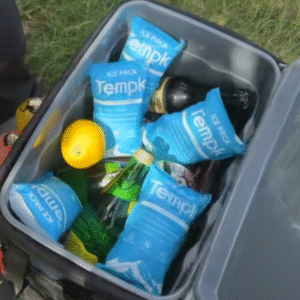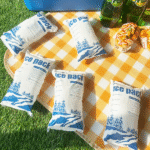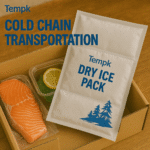Dry Ice Packs for Next Day Shipping: Ensuring Safe and Efficient Delivery
Shipping perishable and temperature-sensitive goods requires precision and care, especially when fast delivery is needed. Packs de glace sec offer an ideal solution for next-day shipping, keeping items frozen and safe throughout transit. This guide will cover everything from the basics of dry ice, how to pack effectively, to understanding the regulatory requirements involved in shipping with dry ice.

-
Understand why dry ice is essential for next-day shipping
-
Learn how to calculate the right amount of dry ice for your shipment
-
Discover the best packaging methods and safety practices
-
Navigate the regulatory landscape of dry ice shipping
-
Stay up-to-date with 2025 Tendances de la logistique de la chaîne du froid
What Makes Dry Ice Essential for Next Day Shipping?
La glace sèche est un dioxyde de carbone solide (Co₂) that sublimates at an incredibly low temperature of -78.5°C (-109.3°F), making it perfect for keeping goods cold during shipping. Contrairement à la glace traditionnelle, which melts into water and can damage goods, La glace sèche sublime directement dans le gaz, ne laissant aucun résidu derrière. This unique property helps preserve the integrity of sensitive items, y compris les produits pharmaceutiques, nourriture, et des échantillons biologiques.
How Dry Ice Works in Shipping
Dry ice sublimates into CO₂ gas as it absorbs heat, maintaining low temperatures for extended periods. When packed properly, it can keep goods frozen for up to 72 heures. This feature is crucial for next-day deliveries, ensuring that items such as frozen foods or vaccines arrive at their destination in optimal condition, without the risk of contamination or temperature deviations.
| Type de produit | Ideal for Shipping | Recommended Packaging | Avantages |
|---|---|---|---|
| Médicaments | Vaccins, insuline, biologique | Conteneurs isolés, Styrofoam boxes | Maintains efficacy and stability |
| Aliments surgelés | Glace, Repas surgelés, fruit de mer | Custom packaging, insulated coolers | Ensures product quality |
| Échantillons biologiques | Blood, tissue, laboratory specimens | Cryogenic storage, specialized packaging | Preserves sample integrity |
How to Pack for Next Day Shipping with Dry Ice
Effective packing is essential to ensuring your dry ice shipment stays cold and safe. Here’s what you need to know about packing dry ice for next-day delivery.
1. Calculer la bonne quantité de glace carbonique
To ensure proper cooling, you must calculate the correct amount of dry ice. A common guideline is to use 5–10 lbs of dry ice per 24 heures de temps d'expédition. This will vary based on the size of the shipment and the duration of transit. Always consider adding extra to account for unexpected delays or variations in temperature.
Exemple de calcul:
Pour un 10 lb shipment, you’ll need approximately 10–15 lbs of dry ice for a 24-hour shipment. For a larger shipment, the dry ice quantity should be adjusted accordingly.
2. Choisissez le bon emballage
Using insulated containers like Styrofoam boxes or polyurethane coolers is crucial for maintaining the cold temperature. Packaging should allow the CO₂ gas to escape as the dry ice sublimates. Sealing packaging too tightly can lead to dangerous pressure buildup, which can cause the container to rupture.
3. Label and Document Your Shipments
Proper labeling is required by regulatory bodies such as the Department of Transportation (POINT) and the International Air Transport Association (Iata). Packages containing dry ice must be clearly marked with:
-
“Glace sèche” ou “Dioxyde de carbone, Solide”
-
Et 1845 (hazardous materials code)
-
Weight of the dry ice in kilograms
-
Shipper’s and recipient’s name and address
En plus, include a Classe 9 Miscellaneous Hazard label if required.
4. Use Reliable Shipping Carriers
Choose carriers that are experienced in handling dry ice shipments. Major logistics providers like FedEx, Hauts, et USPS offer next-day delivery services with proper packaging and documentation. Be sure to verify their requirements and weight limits, as regulations may differ by carrier.
Best Practices and Common Mistakes to Avoid
Common Mistakes to Avoid in Dry Ice Shipping
-
Improper Packaging: Failing to use insulated packaging or airtight containers can lead to the dry ice sublimating too quickly.
-
Incorrect Dry Ice Quantity: Using too little dry ice results in inadequate cooling, while using too much can cause excessive pressure in the package.
-
Not Ventilating Packaging: Dry ice releases CO₂ gas, which can build up pressure if the package isn’t properly ventilated, causing safety issues.
-
Failure to Comply with Regulations: Dry ice is considered hazardous, so it’s critical to adhere to all regulations for labeling and documentation to avoid delays or penalties.
Exemple du monde réel
A pharmaceutical company successfully used the right dry ice amount and insulated packaging to ship critical vaccine doses overnight. The shipment arrived safely with the required temperature maintained, demonstrating how careful planning and proper packing can prevent spoilage and ensure customer satisfaction.
2025 Tendances de l'expédition de la glace sèche
Dans 2025, the cold chain logistics industry is evolving, with new technologies and environmental considerations shaping the future of dry ice shipping.
Tendances clés:
-
Focus sur la durabilité: Companies are exploring eco-friendly alternatives and practices to reduce CO₂ emissions associated with dry ice production and use.
-
Solutions d'emballage intelligents: Advanced packaging technologies will provide more precise temperature control and real-time monitoring of shipments.
-
AI and Automation: Artificial intelligence is being integrated to optimize dry ice usage, predict sublimation rates, and enhance efficiency in cold chain operations.
Technologies émergentes
-
Matériaux à changement de phase (PCMS): Blending dry ice with PCMs helps extend cooling time while reducing environmental impact.
-
Machine Learning: AI systems that predict temperature shifts and adjust dry ice quantities in real time to improve efficiency and reduce waste.
Questions fréquemment posées
Q1: How long does dry ice last during shipment?
Dry ice typically lasts 18–24 hours in transit, depending on the packaging, quantité de glace sèche, and ambient conditions. Pre-chilling your products and using high-density insulation will help extend its effectiveness.
Q2: Can I ship dry ice internationally?
Oui, dry ice can be shipped internationally. Cependant, specific regulations vary by country, and additional documentation may be required. Always check with your carrier for international shipping guidelines.
Q3: Is it safe to handle dry ice?
Oui, dry ice is safe when handled properly. Always wear protective gloves and goggles to prevent frostbite and ensure adequate ventilation to avoid CO₂ buildup.
Conclusion et recommandations
Dry ice is a reliable and efficient solution for shipping temperature-sensitive products, especially when fast delivery is needed. By calculating the right amount of dry ice, selecting proper packaging, and complying with regulatory requirements, Vous pouvez vous assurer que vos envois arrivent en toute sécurité et à l'heure.
Étapes exploitables:
-
Calculate your dry ice requirements based on the weight and transit time of your shipment.
-
Choisissez un emballage approprié that allows gas release and provides adequate insulation.
-
Comply with carrier regulations and include the necessary documentation for smooth transit.
-
Track shipments for real-time monitoring and peace of mind.
À propos du tempk
Tempk is a leading provider of temperature-controlled packaging solutions. Nos produits, including dry ice packs, PCM blends, and advanced insulation materials, are designed to ensure that your perishable shipments are delivered safely and on time. We prioritize sustainability and innovation to meet the evolving needs of our customers in the food, pharmaceutique, and biotech industries.
Contactez-nous: For expert advice on shipping with dry ice, contactez notre équipe dès aujourd'hui!























